My name is David Morrish (AKA Kingflytailoring) and I am venturing to new territory regarding embroidery.
Digital Embroidery Breaking Barriers, Shattering Preconceptions and Painting with Threads is my new journey in the world of creative arts.
When you hear the term digital embroidery, I suspect like many people you think of t-shirt logos, badges, patches, or emblems proudly displayed on school uniforms and signs of allegiance on football and sporting attire.
You may even think of it as “cheating” or “the poor relation to hand embroidery”, therefore dismissing it as a “real” skill or recognised form of art.o
But I am here to show you that digital embroidery can be much much more, a platform that can transcend boundaries, cultures, open opportunities, adding qualities to 2D work that are not possible through printing alone. I am here to break any preconceptions you may have and open your mind to the untapped potential this form of creative media can offer.
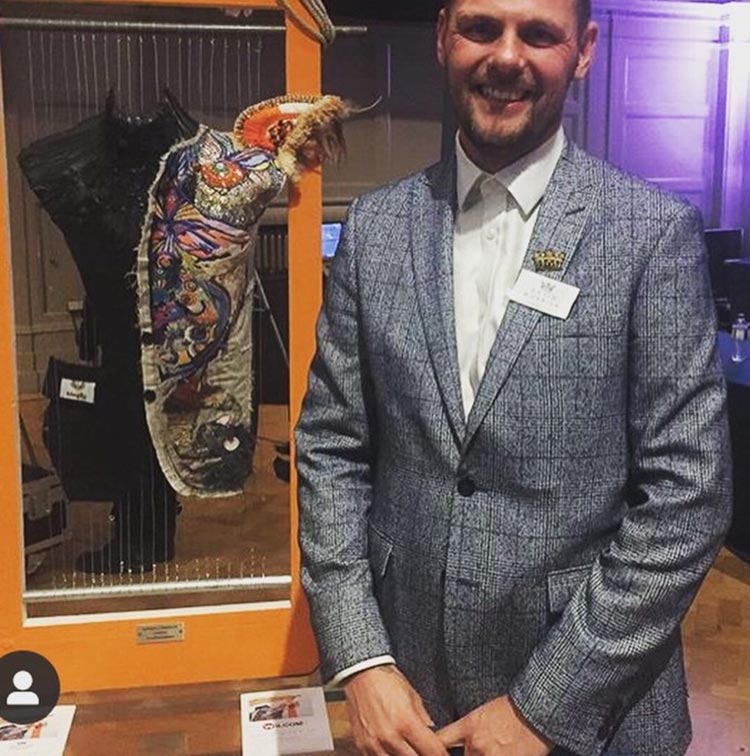
So a little bit about me
I have always been fascinated with art and design and creativity, questioning methods and processes in an attempt to challenge the status quo and offer alternatives to how things are done. I was the child that hated it when people said “This is how you do it, it’s always been done this way, you must continue to do it this way”.. particularly when it comes to subjective, creative subjects
You may call it rebellion, some call it arrogance, but I like to term it, Disruptive Curiosity”.
Working my way through art college, specialising in Fashion at degree level, I developed a very inquisitive acumen and being the late 90s, I was encouraged to break rules and boundaries, which was further accelerated by visiting the infamous 1997 Sensations Exhibition at the RCA in London, Damien Hirst’s work I can still visualise to these days when I close my eyes. Seeing the groundbreaking and emotionally responsive work of the Young British Artists, shaped and continue to mould my own mindset and how I approach the world.
“Why be a duck in a pond of ducks when you can be a flamingo?”
Why Embroidery
Embroidery I had never really considered within my practice until many years later, mainly due to my lack of awareness, access, skill set and financial restrictions. Although I was aware of it, I didn’t realise its creative potential until much later in life.
In 2020, a year of turmoil, unpredictability and fear, I was fortunate to complete a Masters Degree in Fashion & Textiles at Nottingham Trent University (UK), where my specialism ultimately ended up focusing on embroidery as a form of personalisation within men’s tailoring. Like a lot of creative processes, this evolved into something much more and I was keen to see where it led me and what doors could open.
A major turning point in my career was winning the Hand & Lock, Wilcom Digital embroiderer of the year award in 2019, with a test sample piece I submitted from my master’s project.
The piece “Natural Order of Things” used symbolism to tell the story of the demise of the Huddersfield Textile industry as a result of the impact of the industrial revolution”.
The outcome resulted in the production of a 5ft embroidered piece of textile art, that combines various processes and techniques crossing several disciplinary areas. Encouraged by the positive support and feedback I gained from this piece, I decided to push the concept further for my final master’s outcome, bringing further elements into the mix, such as sustainability, activism, collaboration, new technologies, traditional artisan skills and performance art.
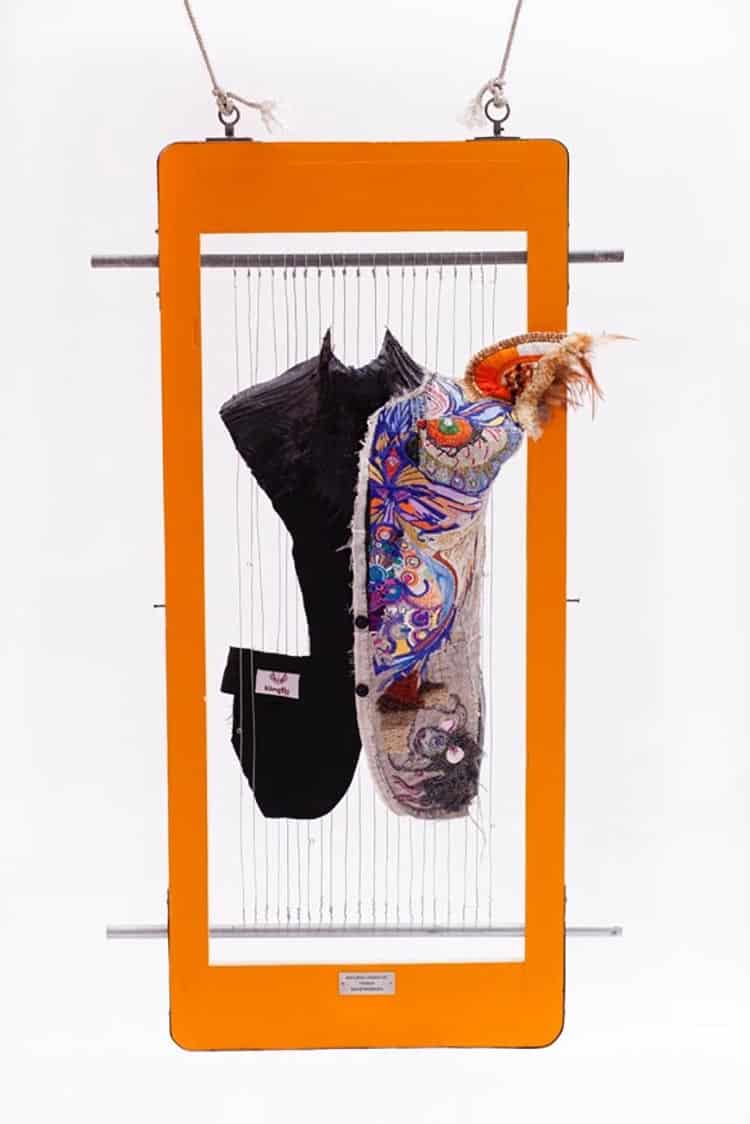

I ended up creating a 26ft long embroidery piece documenting the litter spotted while competing in the Brathay Windermere Marathon. Working collaboratively with the Sheffield branch of the Embroiderer’s Guild I was able to combine and fuse hand and digital embroidery, bringing a vast to a range of styles, techniques and approaches together, resulting in a Bayeaux Tapestry Esq artefact that has impact and purposeful meaning.
Windermere Am I Still Beautiful? 26ft Embroidery in collaboration with the Sheffield Branch of the Embroiderer’s Guild.) 2020

Digital Embroidery As An Art Form
Under the name Kingflytailoring and utilising the social media platform Instagram, I have made it my mission to elevate the status and reputation of digital embroidery as an art form, leaving the cheap badge image behind and moving it towards that of fine art paintings and one of a kind sculptures.
So how are you going to do this you may ask? Well, my theory is that by showing the world my practice, being transparent and honest about my process and creating outcomes that transcend multi-disciplinary boundaries, it will enlighten my follower’s imaginations and encourage a rethink in attitudes. Through collaborations, I targeted artists and designers whose work was all very different, often (but not always) established in their own field and spanning subjects that were not widely associated with this form of medium.

Initially, I consciously stayed away from florals, birds and insects (Themes very common within hand embroidery) and targeted artists and designers whose work and style addressed a wide range of subject matter. My first collaboration was with the British fashion designer Sadie Williams, taking one of her hand painting chevron designs and recreating it in the thread.
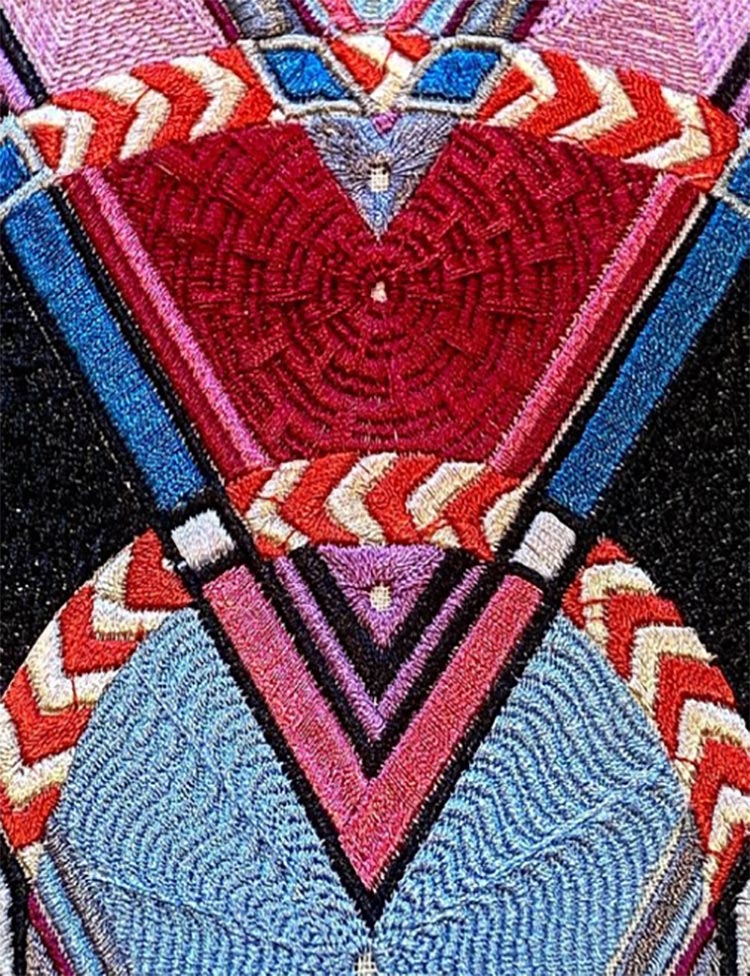
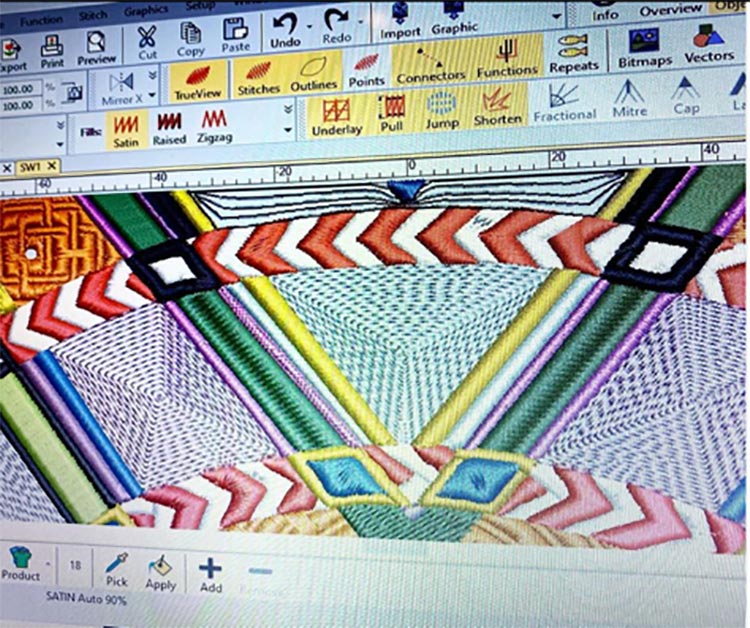

It is sad, but the reality is that the outcome is the most important aspect, but for me, the creative process is where the excitement and learning take place, this part is rarely seen by the client. Taking a flat image, the challenge was to recreate it paying respect to the artist, but also showcase what embroidery could add as an additional extra (Yes, I also wanted to bring some of me and my style in the mix but this was early days and didn’t want to overstep the mark and upset my first collaborative partnership).
Geometric shapes and contrasting colours play perfectly in the hands of digital embroidery as the potential for various fill types and machine manipulation is vast. (More on machine manipulation later). Needless to say the outcome of the piece was well-received, not only by my followers but also by the artists and her followers. This really was the point I felt that there could be something here, something special and something I was excited to keep going with.
Attempting a more natural (unforced) theme, I took the challenge of recreating a 12wk baby scan image for a relative. This piece asked for a looser more organic feel, more curves and abstract detailing. To achieve this the I had to amend my process a little.



The Process
The start has to come from somewhere right, a photograph, drawing, collage, illustration etc. Depending on the quality and clarity of the starting image, it can have a massive impact on how long the next stages take and the overall outcome quality. The most ideal images are clear, vector-based ones with clear colour contrasts and little tonal shading, however, most of my clients starting images are not like this at all they may be just ideas, doodles, poor quality photos, multiple part photos I have to piece together or sketches and often I need to spend hours cleaning and refining the source image before I can move forward. Once I am reasonably happy with the vector (or cartoon-like) image I then take this and process it through a specialist embroidery software, Wilcom E4.
This program allows me to add stitches to my artwork and this is where the real magic begins. Knowing when and how to change the design, which stitches types will work best and what colours are most appropriate requires not only a creative eye but also technical know-how, vision, confidence and an open-minded acumen.
Once this is done, you send it to a machine, press start and hey presto its finished, Yes? Well, Not quite!
For commercial badges and mass-produced pieces, then this is the aim to reduce time wastage and ensure consistent quality in product outcomes but my pieces are bespoke one of a kind.
No Two Pieces Are The Same
‘Me (or anyone else) can’t recreate them exactly the same and that is because my design process does not end until the final stitch has been sewn in the cloth.
This is where DISRUPTIVE MACHINE MANIPULATION, comes into play essentially, as the machine physically embroiders, I, as the designer, artist and operator react to what is happening in front of my eyes at a given time, using my creative judgement and aesthetic taste (And emotion levels) to interfere with the machine.
I can stop, repeat, skip, change colour, misalign, add to and more giving the artist (me) more control and influence within the design and make the process.
“Spontaneous, instinctive and reactive design.”
To some extent the way I work could be compared to that of a fine art painter, hand embroiderer or any other artist comes to that.
“The only thing I am not doing is physically putting the needle in the cloth (or brush to canvas,) using my own hand”.
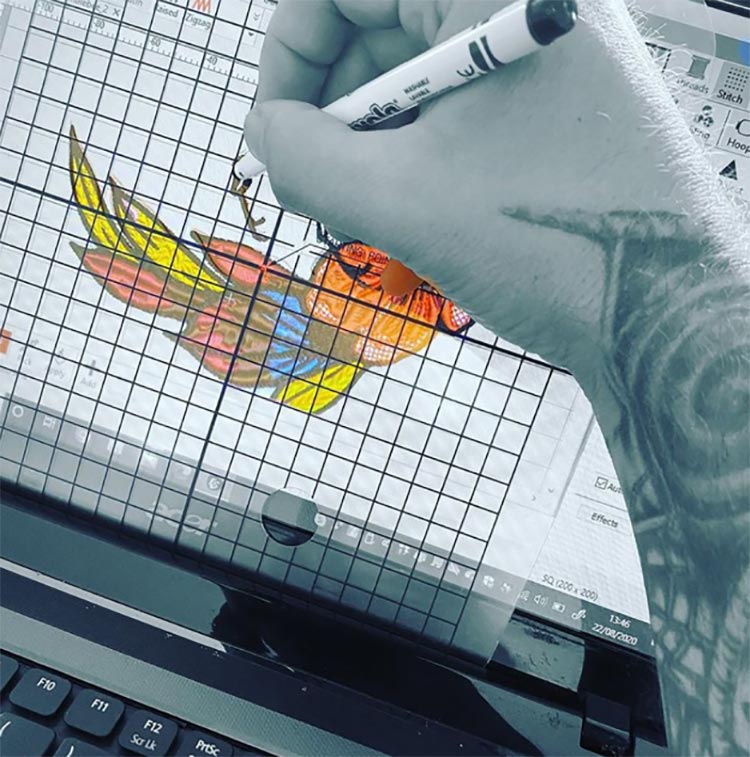

Due to machine capabilities, most of my larger pieces require multiple hoopings, this is because of restrictions in size and stitch quantity limitations. This itself causes massive complications in not only the splitting of the CAD work, but also the alignment on the physical cloth itself, thus increasing the risk of image misplacement quite significantly per rehooping. One mis-hooping can ruin a piece altogether as the section joins will be visible and once embroidered it is near impossible to unpick without damaging the cloth. It really is a get it right the first-time situation.

This particular piece (The Bubmble Bee) is based on a tattoo by Leeds based tattoo artist Daryl Watson, required 4 hoopings in total, with a combined total time of 30-40 hours from beginning to end.
So.. Fashion designers, tattooists… whom else.. you may be wondering.
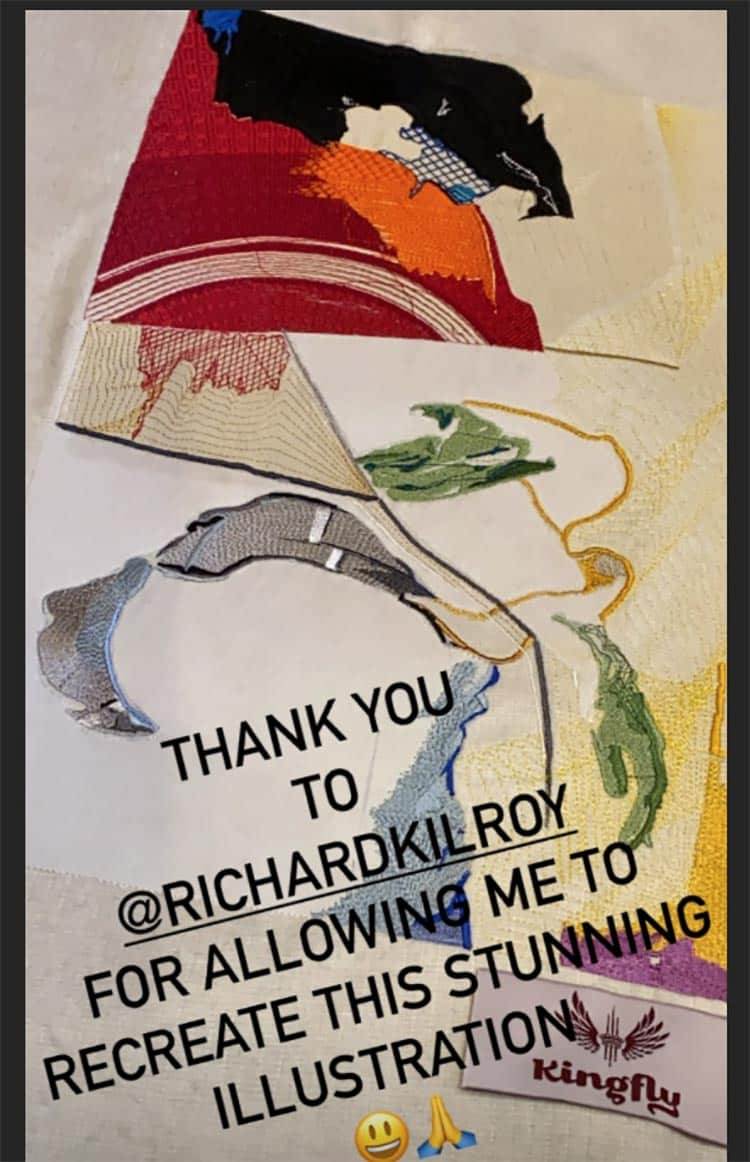

New York-based street artist and illustrator Jeremyville.
Established fashion illustrator Richard Kilroy.
Carmen the Camel by American artist, blogger @travelwritedraw

Dior Painting by the highly influential fashion illustrator – David Downton

(On the left is the original painting and on the right a close up of the recreated embroidery
Grafitti artist @Keverones resulted in a bold geometric piece full of intrigue and tactile qualities.
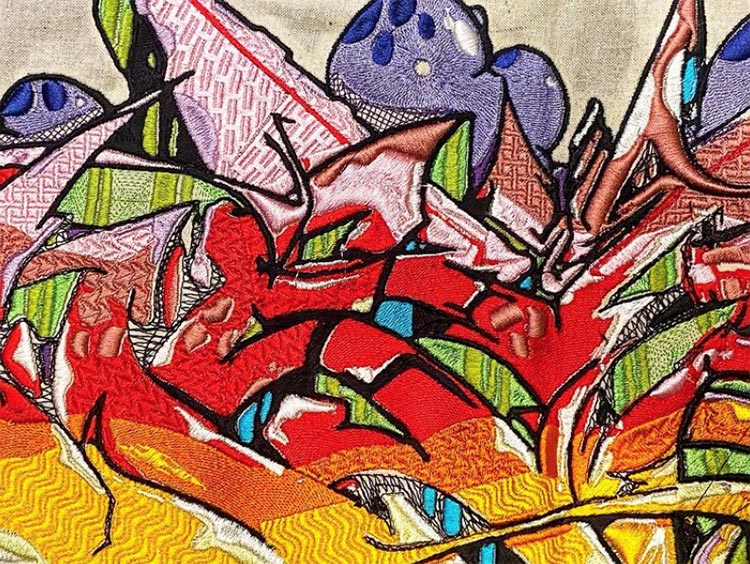
UK based illustrator @Wilbroome adding a hairy touch to this friendly monster and cuteness to his Xmas Cat in Hat.
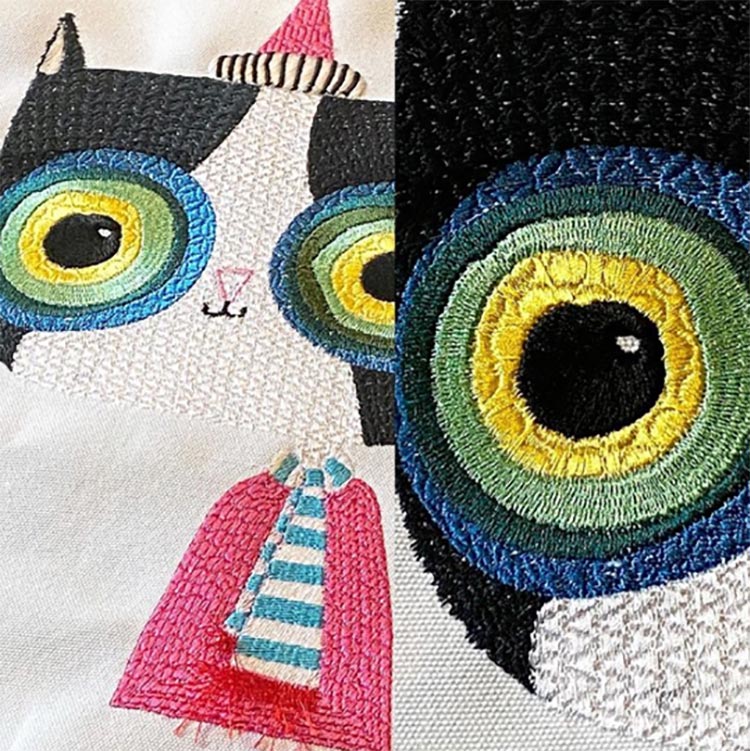

Makeup Artists @Fancyflutie


Fashion illustrator @Lauralaine

The Challenges
My latest and most ambitious piece to date, with a completed size of 71cm x 53 and requiring 15 hoops. This is work in progress and I estimate it will take up between 100-150 hours of my time in total. It is a truly one of a kind piece, that deserves its place on the wall for all to appreciate.
A painter drafts his subject, mixes paint and using his or her skill and creative vision paints the subject matter in their style directly onto the canvas for me, I draft the composition, refine, adapt, amend and develop through 2 cad programmes and then when actually embroidering I use the machine as a tool, similar to a painters brush to bring it to life and give it a visual presence.
The difficulties, complications and risks are high, repeating and redoing is seldom an option and for these reasons alone I am keen to show the world what my work entails, so I can elevate the appreciation and value of this form of art something I wholeheartedly feel it deserves.
How Many Can Machine Embroider?
“My dream is to one day, see my work hung in a prestigious art gallery, alongside priceless paintings from world-renowned painters.”
Watch this space and follow me on Instagram @kingflytailoring to see my journey continue.
We must preserve the arts.
If you like this post can you place share it via Pinterest?
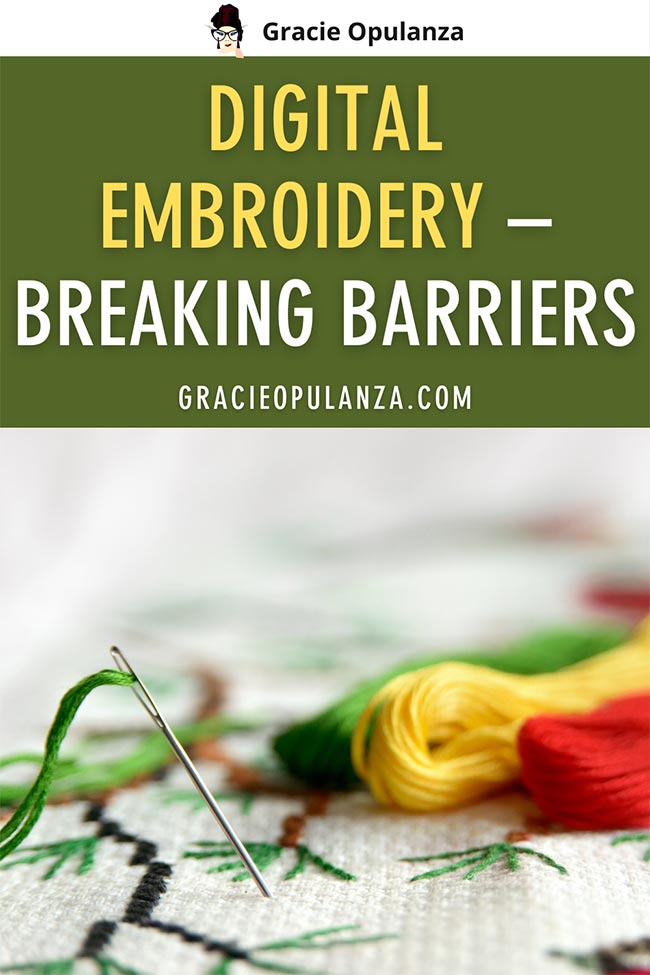

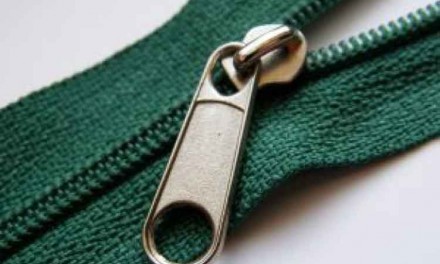
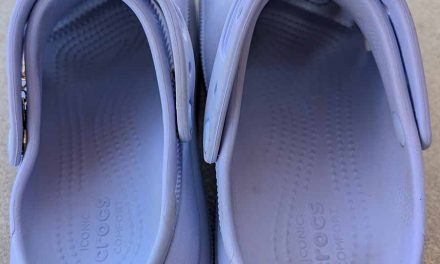
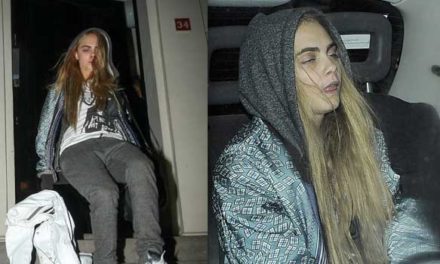
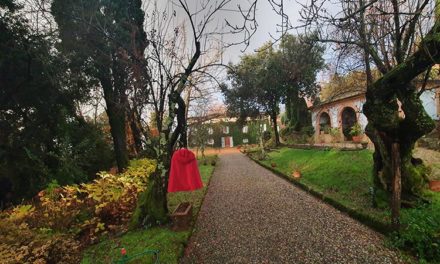
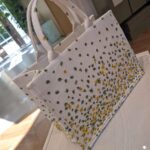


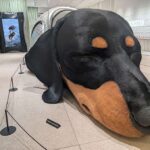


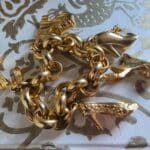

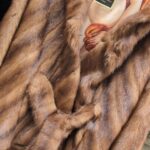

You must be logged in to post a comment.